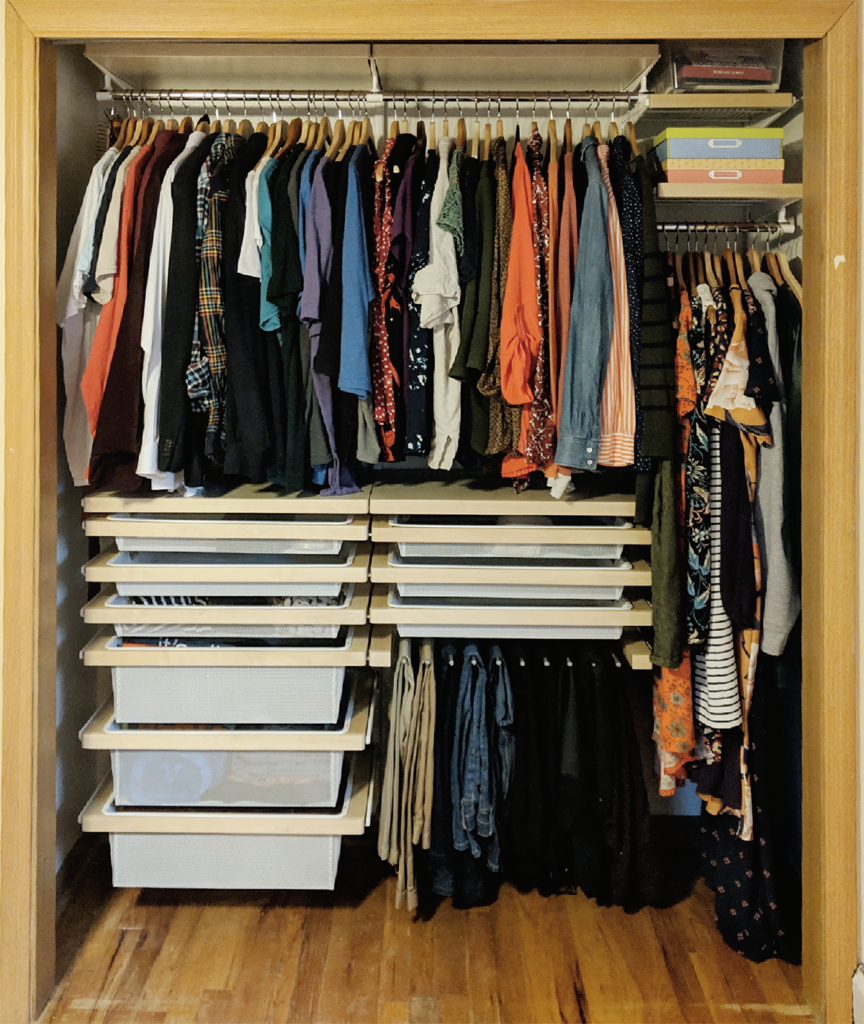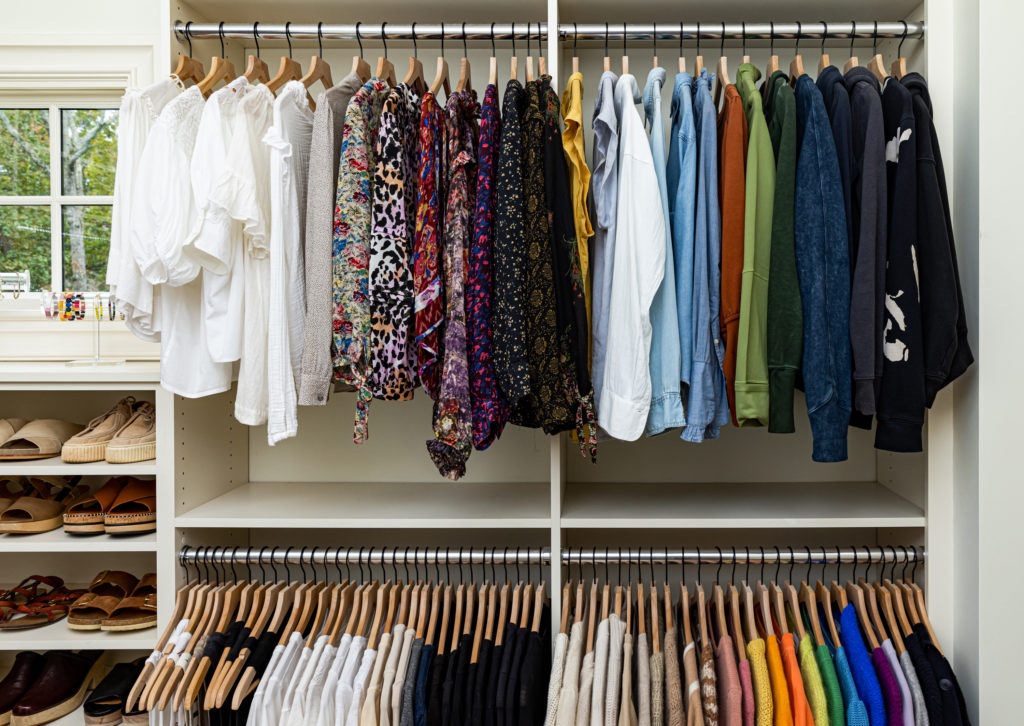Get motivated to sort through old clothes — the smart way — with this advice from Raleigh organizing pros.
by Emily Gajda

The beginning of a new year is a wonderful time to mindfully refresh your space, and your closet is a great place to start. Maybe you scored a new pair of leggings at one of those post-holiday sales… or a special someone gave you a beautiful sweater for Christmas. The end of the year tends to bring an influx of stuff… and all of it needs a place to live.
So you take your new clothes up to your closet, pop them in a drawer or on a hanger, close the door and walk away.
All sounds good, right? Wrong.
Chances are you already a similar sweater or another pair of leggings in there — and you may not have put the new items close to the ones you had already. Repeat for a few more sales or special occasions, and your closet ends up looking like mine did: a mixed-up jumble of sweaters, dresses and jeans. It made getting dressed, even when I wasn’t running late, a frenzied fight between me and the fabric.
So, with the help of three Raleigh organizing experts — I decided to give my closet makeover. I spoke with Laura Morgan of Sorted Out, Leah Friedman, professional organizer and founder of Raleigh Green Gables, Allison Flinn, professional organizer and founder of Reclaim Professional Organizing, and Kate Fisher of The Neatist. They offered tips on how to sort through my clothing, figure out what to keep and what to donate, and then put it all back in the most logical way.
With their help, I now have a closet that actually helps me get dressed in the morning. Here are 6 steps to a more organized closet, according to the pros.

Step 1: Make the Time to Organize
The first thing all of the professional organizers recommended was to set aside time, whether it’s an entire Saturday or 15 minutes each evening.
“What happens is: we look at it, we close the door, and then the project just hangs over us all the time. So what we want to do is recognize that there’s an issue here. Maybe it’s not even a bad issue, maybe it’s just time for a refresh,” says Morgan.
Making the time to get this project done from start to finish is fundamental to avoiding the “throw away” and “donate” piles that can live on your closet floor for weeks. I even went as far as to put my time block on my phone’s calendar.
If you can block the time for a whole day, that’s fantastic, but it’s important to be realistic about the time you have available (and how long it’ll take — usually at least an hour or two, depending on how much clothing you have). Once you reach your appointed time, make it as pleasant as possible: make a playlist, bring a beverage, or enlist a friend to sweeten the deal. “Cleaning out and organizing should be fun!” says Morgan.
Step 2: Sort What You Have
It’s critical to take everything out of your closet, whether you do it piece by piece or pull it all out at once and put it in a big pile. Then, look at every single garment.
“You’ve got to love love it, you can’t just love it, in order to keep it,” says Friedman. ”Be ruthless and just get rid of the guilt — it’s okay to have spent money on something and then changed your mind.”
You might think that your wardrobe is primarily things you wear, but chances are there are lots of garments in there that you never put on your body. Things have a way of hiding in the back of the closet!
As you sort, make two piles: one to keep, and one to get rid of (we’ll talk about donating or throwing away later on). Everything in your closet should end up in one of these two piles before you move onto the next phase.
Step 3: Figure Out What You Really Need & Use
Set aside that pile of things you don’t love love, then turn your focus to the ‘keep’ pile. This is when you should start to group things with similar things: “place like with like” as a few of my experts said.
“That way you can see how many you have of a particular item. Like, you may love black yoga pants and wear them often to work out — but how many pairs of black yoga pants can one person need?” says Flinn.
Sorted like with like, focusing on clothing type, sleeve or pant length, and color. If you’re like me, you will be in shock when you see how many, for example, solid black tops you own — and it might help you realize that you only really wear one or two of them.
This step makes what you have too much of super clear. As you group items, do not be afraid to move some more things into the “get rid of” pile.

Step 4: Organize What’s Left
By now, your wardrobe should be significantly pared down, and fitting everything in should be much easier than it was before. But a totally empty closet can be daunting, and there are some things to consider while deciding where to put everything.
The first thing to prioritize is putting clothes or items that you wear often in close reach. If you wear blouses to work every day, maybe hang them in the easiest place for you to get to quickly. I run often, so I made sure my running clothes were easy to get to.
But for seasonal items like swimsuits or ski pants, it might be a good idea to utilize one of those harder-to-reach shelves until the time comes around to use those items. Naturally, things you wear often enough but not all the time should go somewhere you can reach them easily, but they don’t need to be front and center.
While organizing, it’s a good time to think about ways to store things more efficiently. For example, it’s easy to just stack clothes on shelves, but remember that piles should only be a few pieces high, like a few chunky sweaters or a few pairs of sweatpants, before things get hard to find or topple over.
When it comes to storing clothes in drawers, file folding — the method popularized by Marie Kondo — seems to be the favorite of the pros. Making sure you can see every piece of clothing in a drawer will keep you from forgetting about things you might otherwise love to wear.
One last tip? Slimline velvet hangers take up about half the space as normal hangers, and they can keep your sweaters and shirts from sliding off the hangers into the abyss of a closet floor.
Step 5: Pass Along What You Don’t Wear
After the big clean out and organizing extravaganza, you should be left with a pile of items that you decided to get rid of.
It’s easiest to wholesale donate everything to an organization with the power to get items to where they’ll be best used — even if you have designer or luxury goods that could be resold. “I think the biggest thing is to be very realistic with yourself: will you commit time to selling things?” Fisher. “If it’s just gonna sit there, then it’s not doing anyone any favors.” I know I’ve had lofty ambitions of selling clothes that were still in my hallway six months later! For both your own peace of mind and for the next wearer, the sooner you move them on, the better.
“If you’re going to sell things, you could put a little reminder on your calendar, say like, a month from then,” Fisher says. If you haven’t started selling things by then, she says, “be firm with yourself and say, I haven’t started selling this stuff, so I should just donate it.”
To donate, consider organizations like North Raleigh Ministries that take any wearable (not damaged or stained) clothing, or order a Take Back Bag from For Days. For Days gives you $20 in store credit when you send them a bag of your old clothing, and it turns anything not wearable into things like insulation to reduce waste. Or visit our guide to where to donate in Raleigh for more ideas.

Step 6: Keep Up the Good Work!
The best way to extend the time between closet clean outs is to continuously evaluate what you have whenever you get dressed.
Say you put on a top and it just doesn’t do it for you anymore. Do you really think it will magically make you feel good next time? Probably not.
So start keeping a small basket in your closet for these garments. Instead of hanging them back up after you take them off, put them in the basket and donate the contents every month or two.
“If I put on an article of clothing and I don’t like the way it feels, I don’t like the way it looks or whatever — I don’t hesitate anymore,” Morgan says. “I just drop it in that basket, which means it’s out of my rotation.”
When the time comes again, block off another day, get your snacks and your water, and get to work — you know what to do.
If it ever gets too overwhelming, or you just want some professional advice, these professional organizing experts would like to remind eager to help, and it’s their job to help you through the daunting process and help you build the closet of your dreams.
This article originally appeared on waltermagazine.com in January 2023.




